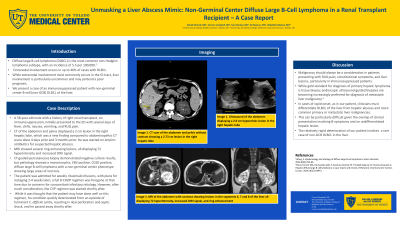Tuesday Poster Session
Category: Liver
P4818 - Unmasking a Liver Abscess Mimic: Non-Germinal Center Diffuse Large B-Cell Lymphoma in a Renal Transplant Recipient - A Case Report
Tuesday, October 29, 2024
10:30 AM - 4:00 PM ET
Location: Exhibit Hall E

Has Audio

Connor Campbell, MD
University of Toledo College Medicine and Life Sciences
Toledo, OH
Presenting Author(s)
Zohaib Ahmed, MD1, Connor Campbell, MD2, Sara Stanley, MD2, Ali Nawras, MD1, Abdallah Kobeissy, MD2
1University of Toledo Medical Center, Toledo, OH; 2University of Toledo College Medicine and Life Sciences, Toledo, OH
Introduction: Diffuse large B-cell lymphoma (DLBCL) is a relatively rare lymphoproliferative disorder affecting more than 18,000 people per year. Extranodal involvement occurs in up to 40% of cases with DLBCL. While extranodal involvement most commonly occurs in the GI tract, liver involvement is particularly uncommon and may portend a poor prognosis. We present a case of an immunosuppressed patient with non-germinal center B-cell (non-GCB) DLBCL.
Case Description/Methods: A 58-year-old male with a history of right renal transplant, on immunosuppression, initially presented to the ED with several days of fever, chills, nausea, vomiting, and RUQ pain. CT of the abdomen and pelvis displayed a 2 cm lesion in the right hepatic lobe, which was a new finding compared to abdominopelvic CT scans done 4 days prior and 3 months prior. He was started on empiric antibiotics for suspected hepatic abscess. MRI showed several ring-enhancing lesions, all displaying T2 hyperintensity and increased DWI signal. CT-guided percutaneous biopsy demonstrated negative culture results, but pathology showed a monomorphic, EBV positive, CD20 positive, diffuse large B-cell lymphoma with a non-germinal center phenotype showing large areas of necrosis. The patient was admitted for weekly rituximab infusions, with plans for restaging 2-4 weeks later; a full R-CHOP regimen was foregone at that time due to concerns for concomitant infectious etiology. However, after much consideration, the CVP regimen was started shortly after. While it was thought that the patient may have done well on this regimen, his condition quickly deteriorated from an episode of fulminant C. difficile colitis, resulting in ileal perforation and septic shock, and he passed away shortly after.
Discussion: Malignancy should always be a consideration in patients presenting with RUQ pain, constitutional symptoms, and liver lesions, particularly in immunosuppressed patients. In cases of rapid onset, as in our patient, clinicians must differentiate DLBCL of the liver from the hepatic abscess and more common primary or metastatic liver malignancies. This can be particularly difficult given the overlap of clinical presentation involving B-symptoms and an undifferentiated hepatic lesion. The relatively rapid deterioration of our patient is a rare case of non-GCB DLBCL in the liver.
Disclosures:
Zohaib Ahmed, MD1, Connor Campbell, MD2, Sara Stanley, MD2, Ali Nawras, MD1, Abdallah Kobeissy, MD2. P4818 - Unmasking a Liver Abscess Mimic: Non-Germinal Center Diffuse Large B-Cell Lymphoma in a Renal Transplant Recipient - A Case Report, ACG 2024 Annual Scientific Meeting Abstracts. Philadelphia, PA: American College of Gastroenterology.
1University of Toledo Medical Center, Toledo, OH; 2University of Toledo College Medicine and Life Sciences, Toledo, OH
Introduction: Diffuse large B-cell lymphoma (DLBCL) is a relatively rare lymphoproliferative disorder affecting more than 18,000 people per year. Extranodal involvement occurs in up to 40% of cases with DLBCL. While extranodal involvement most commonly occurs in the GI tract, liver involvement is particularly uncommon and may portend a poor prognosis. We present a case of an immunosuppressed patient with non-germinal center B-cell (non-GCB) DLBCL.
Case Description/Methods: A 58-year-old male with a history of right renal transplant, on immunosuppression, initially presented to the ED with several days of fever, chills, nausea, vomiting, and RUQ pain. CT of the abdomen and pelvis displayed a 2 cm lesion in the right hepatic lobe, which was a new finding compared to abdominopelvic CT scans done 4 days prior and 3 months prior. He was started on empiric antibiotics for suspected hepatic abscess. MRI showed several ring-enhancing lesions, all displaying T2 hyperintensity and increased DWI signal. CT-guided percutaneous biopsy demonstrated negative culture results, but pathology showed a monomorphic, EBV positive, CD20 positive, diffuse large B-cell lymphoma with a non-germinal center phenotype showing large areas of necrosis. The patient was admitted for weekly rituximab infusions, with plans for restaging 2-4 weeks later; a full R-CHOP regimen was foregone at that time due to concerns for concomitant infectious etiology. However, after much consideration, the CVP regimen was started shortly after. While it was thought that the patient may have done well on this regimen, his condition quickly deteriorated from an episode of fulminant C. difficile colitis, resulting in ileal perforation and septic shock, and he passed away shortly after.
Discussion: Malignancy should always be a consideration in patients presenting with RUQ pain, constitutional symptoms, and liver lesions, particularly in immunosuppressed patients. In cases of rapid onset, as in our patient, clinicians must differentiate DLBCL of the liver from the hepatic abscess and more common primary or metastatic liver malignancies. This can be particularly difficult given the overlap of clinical presentation involving B-symptoms and an undifferentiated hepatic lesion. The relatively rapid deterioration of our patient is a rare case of non-GCB DLBCL in the liver.
Disclosures:
Zohaib Ahmed indicated no relevant financial relationships.
Connor Campbell indicated no relevant financial relationships.
Sara Stanley indicated no relevant financial relationships.
Ali Nawras indicated no relevant financial relationships.
Abdallah Kobeissy indicated no relevant financial relationships.
Zohaib Ahmed, MD1, Connor Campbell, MD2, Sara Stanley, MD2, Ali Nawras, MD1, Abdallah Kobeissy, MD2. P4818 - Unmasking a Liver Abscess Mimic: Non-Germinal Center Diffuse Large B-Cell Lymphoma in a Renal Transplant Recipient - A Case Report, ACG 2024 Annual Scientific Meeting Abstracts. Philadelphia, PA: American College of Gastroenterology.
